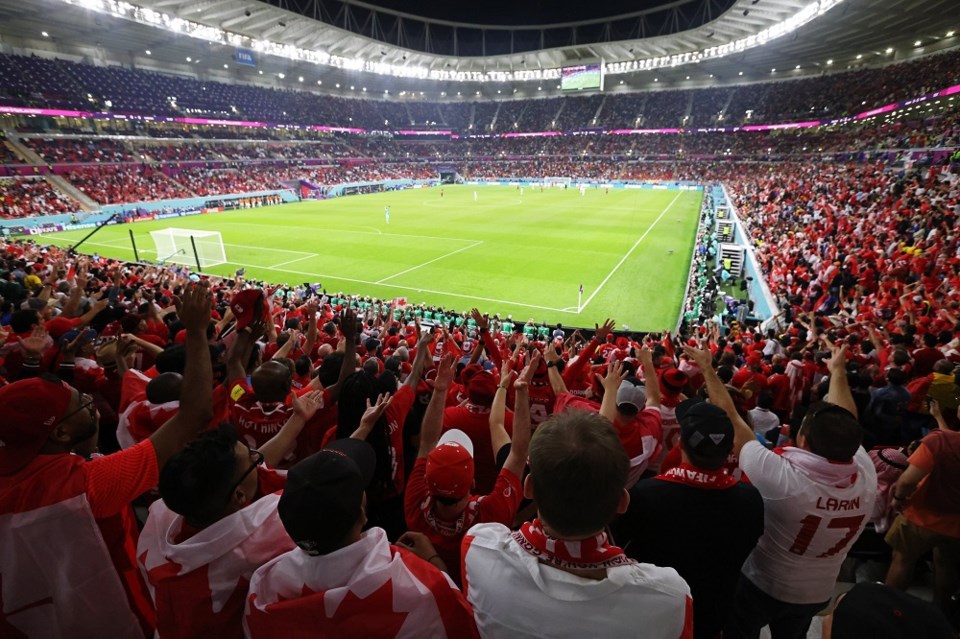When Canada finally returned to the FIFA World Cup in Qatar with a narrow 1-0 loss to number two-ranked Belgium, it didn’t look like a team that lost an opportunity to play a key warm-up match.
Back in June, players staged a strike that scuttled a friendly against Panama, the replacement for the cancelled B.C. Place Stadium meeting with World Cup-bound Iran. The Canadian Soccer Association had not agreed to share the Qatar 2022 appearance money of at least $10 million. Players wanted 40% of the sum, travel, accommodation and tickets to Qatar for friends and family and pay equity for the women’s team. CSA president Nick Bontis dismissed the players’ demands as “untenable.”
The squad was shocked to learn that the CSA had virtually given away most of its marketing rights to Canadian Soccer Business, a private entity behind the Canadian Premier League and the OneSoccer streaming service.
Bontis said in a Nov. 9 webcast with the National Soccer Coaches Association of Canada that the CSA was nearing an equitable deal with players on both the men’s and women’s teams and many of their concerns were being addressed.
North Vancouver lawyer Ron Perrick represented the players the first time Canada qualified for the World Cup, at Mexico 1986. For him, history was repeating.
“The controversy was a result of the CSA not getting their ducks in a row and getting some aggressive marketing out there for the players,” Perrick said. “I mean, the only player that we were hearing about was [Alphonso] Davies. We didn't hear a lot about all the other players. There was no profile.”
Perrick felt the CSA should have bargained fairly and openly with the players as soon as they finished as the top qualifier from the North and Central American and Caribbean (CONCACAF) zone in March. Especially since they automatically qualify for 2026 when Vancouver and Toronto are among the host cities.
“This tournament [in Qatar] will set the table for the next one, and a lot of these players will be around and then that'll give the incentive for a lot of other young players to want to get on that team and it should snowball in the right direction,” he said.
It came down to the wire 36 years ago. A month before Canada debuted at Mexico 1986, Perrick reached a deal with the CSA that included training camp per diems, $1,500 per game per player, and a percentage of the CSA’s receipts from FIFA. “If the CSA does well, the players will do well,” Perrick said at the time.
The deal came after Molson Breweries put up a half-million dollars for the players, who were playing in a post-North American Soccer League environment in Europe, the Major Indoor Soccer League and even in domestic senior men’s leagues. CSA chief operating officer Kevan Pipe balked.
“We locked horns,” Perrick recalled. “I came to a deal and what we did is we shared it, and then each player was allowed to go out and get his own sponsorships, and he could retain the money for that. As a collective group, we would split the money up with that, and we would share with the CSA and they would share with us.”
Friendlies in Vancouver against Wales and Burnaby against England went ahead. The team lost its matches in Mexico against the Soviet Union, France and Hungary.
After failing to qualify for Italy 1990, the stakes were high for 1994, when the tournament was going to be next door in the U.S. CSA secretly sold the rights for a Toronto qualifier against Mexico to the owner of the Toronto Blizzard for $100,000 and let him keep proceeds from the gate receipts. Perrick continued to negotiate with Pipe as Canada prepared for a match in Edmonton against Australia at the end of July 1993, the first of a home-and-home series for a wildcard berth in USA 1994. Perrick and Pipe didn’t reach a deal.
“We didn't say strike, we just weren't going to play,” Perrick said.
Perrick left his Edmonton hotel to return to Vancouver. On the way out, he stopped for a drink and a chat with Jim Taylor in the lounge. The legendary sports columnist later told a radio show the game wasn’t going to happen.
“That caused a lot of excitement,” Perrick said. “By the time I got back to Vancouver, into my house, we had a deal. It was a good one for the players and when the Australian guys found out what the Canadian players were making, when they had the return match back in Australia, they went on strike. It was pretty funny actually.”
Perrick negotiated for the players to receive $1,750 per game and $250 per point. They would have received a $5,000 had they advanced to the 1994 tournament.
Canada did play in the U.S., albeit more than six years later when they won the 2000 CONCACAF Gold Cup in Los Angeles. It was the men’s national team’s biggest achievement prior to 2022. Perrick negotiated for the players to receive $3,000 for a win, $2,500 for a tie, $2,000 for a loss, whether they were on the pitch or on the bench.
Since then, soccer has grown in Canada, through Major League Soccer’s expansion, recruitment of Canadian players by top European teams, and TV and streaming deals that showcase the best teams and players.
“Everybody should get rewarded, and if you've got smart people or good people in the marketing positions, the sky’s really the limit, and it should be,” Perrick said.



